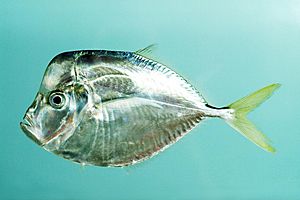Atlantic moonfish facts for kids
Quick facts for kids Atlantic moonfish |
|
|---|---|
 |
|
| Conservation status | |
| Scientific classification | |
| Synonyms | |
|
The Atlantic moonfish (scientific name: Selene setapinnis) is a cool fish found in the western part of the Atlantic Ocean. It belongs to a family of fish called Carangidae, which includes jacks and pompanos.
Contents
What Does the Atlantic Moonfish Look Like?
The Atlantic moonfish has a unique shape. It is thin and very flat from side to side, almost like a pancake! It has a fin on its back called the dorsal fin, which has 8 sharp spines. It also has a fin underneath, the anal fin, with 2 spines.
Its mouth is interesting too. The upper jaw is short, but the lower jaw sticks out further. The fish has a forehead that slopes and bends, and its eyes are quite big. Its tail fin is forked, like a "V" shape. This tail is connected to a strong, hard part called the caudal peduncle.
You might notice a faint spot near the base of its pectoral fins (the fins on its sides). The Atlantic moonfish is usually silvery or metallic blue. Its tail fin often has a yellowish color. The edges of its back fin and the caudal peduncle area are lined with a dark color.
What Do Atlantic Moonfish Eat?
Adult Atlantic moonfish are hunters. They mostly eat small fish. They also enjoy eating tiny sea creatures called crustaceans, like shrimp or crabs.
Where Do Atlantic Moonfish Live?
Atlantic moonfish often swim together in groups, called schools. They like to live near the bottom of coastal waters. Young moonfish, called juveniles, can be found in muddy areas where fresh and saltwater mix, known as brackish waters.
These fish usually live in water depths from 0 to 55 meters (about 0 to 180 feet). They prefer warmer, subtropical parts of the ocean.
Where Can You Find Atlantic Moonfish?
You can find Atlantic moonfish in the western Atlantic Ocean. They live along the coasts from Nova Scotia, Canada, all the way down to Argentina in South America. This includes the coasts of the Gulf of Mexico. In the eastern Atlantic Ocean, you'll find a similar fish called Selene dorsalis instead.
How Did the Atlantic Moonfish Get Its Name?
The Atlantic moonfish was first officially described in 1815. An American fish expert named Samuel L. Mitchill gave it the scientific name Zeus setapinnis back then. He found the first known fish in the Bay of New York.
The first part of its modern scientific name, Selene, comes from an ancient Greek word meaning "moon". This name was chosen because some fish in this group, like the Lookdown, have a vague moon-like shape.
The second part of its name, setapinnis, is made of two Latin words: seta means "bristle" and pinnis means "fin". This part of the name refers to the bristly, pointed tips of its dorsal fin (back fin) and anal fin (bottom fin).
See also
 In Spanish: Selene setapinnis para niños
In Spanish: Selene setapinnis para niños


